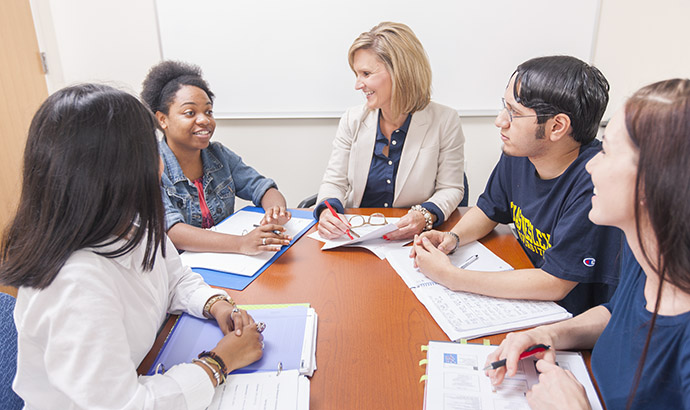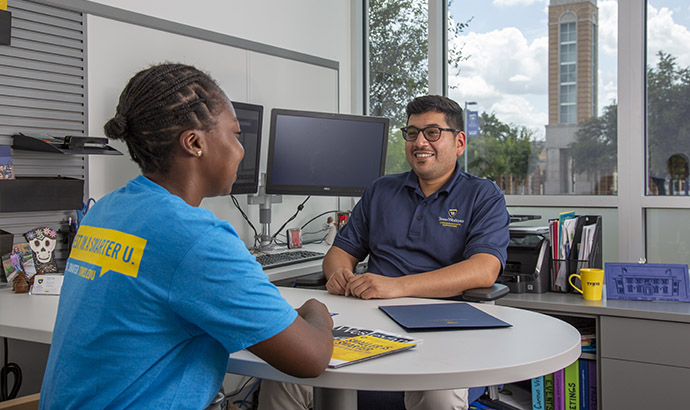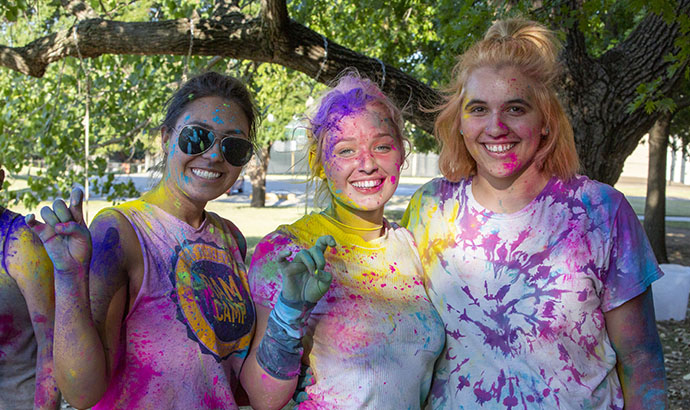Student Engagement in the Higher Education Classroom
.jpg)
“There is greater teaching and learning when there is plentiful: 1) student faculty contact, 2) cooperation among students, 3) active learning, 4) prompt feedback, 5) emphasizing of time on task, 6) high expectations, and 7) respect of diverse talents and ways of learning” (Chickering & Gamson, 1987). This is true in all aspects of higher education, especially within the classroom. According to a recent survey of college students from 13 countries, 88% said the quality of faculty played a significant role in student success, while 86% reported that engaging classroom content and hands-on learning opportunities were also vital” (Watermark Insights, 2024).
“They don’t participate in discussions. They don’t interact. How do I engage my students?” That is the age-old concern from instructors and teachers at every level. We will dive into ways you can address student engagement and what you can incorporate into your course to impact the learning process.
But first...remember:
As you are working to improve engagement in your course and within the classroom (whether it is in-person or virtual), keep a few things in mind.
- Intentionality leads to impact
- Making changes can be time consuming
- Student engagement does not change overnight
- Strategies could be adjusted for any modality
- Does the use of technology take away from the content?
Three Types of Engagement
Research breaks down engagement into three types.
Behavioral engagement involves students’ participation in academic and extracurricular activities, adherence to rules, and effort put into learning tasks (Hong et al., 2020). Active participation in class discussions, consistent attendance, and assignment submission are markers of behavioral engagement. It has been shown that high behavioral engagement contributes to better academic outcomes and retention (Sá, 2023).
Cognitive engagement refers to students’ investment in their learning process, including the use of deep learning strategies, critical thinking, and the desire to understand complex concepts (Sesmiyanti, 2018). Students engaged cognitively are more likely to persist through challenges, develop grit, and achieve deeper mastery of the material (Sá, 2023).
Emotional engagement reflects students’ feelings of belonging, interest, and enthusiasm. Students who feel connected to their institution and emotionally supported are more likely to remain engaged and committed to their studies (Senior et al., 2018).
Our natural instinct is to often notice the lack of behavioral engagement, including students not participating in discussion, not attending class, and not turning in assignments. It is important to focus on having a balance of the three as they build on each other.
Impacting Student Engagement
We can impact student engagement in the college classroom within three areas: course structure, content and instruction, and relationships.
Course Structure
When developing courses from the beginning, we often forget that we can influence student engagement within the structure of the course. The design and flow of a course should encourage the learning process within the students.
The “vibe” of the course. As instructors, you set the tone of the course from the first day (or earlier). This has an impact on how motivated and excited students are about the course as a whole.
Consider the following questions as you evaluate the vibe of your course.
- Is the class time valuable? Students need to find a reason and a purpose to attend and participate in a class. If they do not see the purpose, they lose motivation.
- Is there an environment of active learning? By having an opportunity and the encouragement to participate and learn by doing, students are interacting with and creating content.
- Do I model engagement? Are we willing to do what we ask others to do?
- Is it a safe learning environment? Students are diving into your content and curriculum for the first time. They need to know that they will not drown and that they have floaties to give support. Offering them a support system (welcoming environment, judgement free zone, clear communication, opportunities to explore and be challenged) gives them the confidence needed to go into the deep end.
Communication is key. This starts before the course starts with a welcome announcement and feeling comfortable with the new experience. It includes the tone that is established and the expectations that are laid out within the syllabus. Clear communication continues throughout the course as assignments, due dates, and activities are implemented. Are reminders used? Are announcements clear and engaging? Are resources and instructor availability clear and easy to find. Is the LMS updated in a timely manner (or earlier)? Most importantly, do you model the communication that you wish to receive? Great communication encourages a student to be more engaged in a course. Ineffective communication creates a barrier.
Content and Instruction
There is a good chance that the topics and content that you teach is something that you are passionate about. Does that passion translate to your students? Often frustration comes when students do not share the same passion that the instructor has. In reality, they may not be (and may never be) at the same level. What can you, as the instructor, do to get students to that level of passion?
Overall, are students given an opportunity to interact?
Interaction from student to student. They learn from each other and from each other’s successes and failures. Do you provide your students opportunities to teach each other, to review each other’s work, and to be involved in conversations with each other?
Interaction from student to instructor. Students need an opportunity (and occasionally, a push) to ask questions of the instructor and to engage with the instructor. As an instructor, you can offer to review projects and activities prior to being submitted. This gives an opportunity for the student to learn from their work and thus, be more engaged in it.
Interaction from instructor to student. As an instructor, do you engage students directly, even when they do not initiate it? Utilizing efficient and effective questioning strategies within the learning process is a way to do this. With this, the student is engaged not only directly with the instructor but also with the content and, possibly, other students.
Interaction from student to content. We know this as active learning. When students “touch” the content, they become more engaged. When students think about the content, they become more engaged. When they see the connection of the content to their lives, their interests, their future, they become more engaged. What opportunities do the students in your class have to interact with the content?
There are numerous strategies to implement that could impact student engagement. Here is a sampling.
- Connection to the real world
- Effective questioning
- Preview materials
- Students involved in modeling, explaining, and teaching
- Vary the style of instruction and presentations
- Flip the classroom or flexible modules
- Collaboration and cooperative learning
- Effective discussion (including discussion groups)
- Discussion board-choice of written or video responses
- Peer review (not just papers)
- Student choice (method of completion, individual or group)
- Student reflection on the learning process
- Give the WHY (connect to objectives and the real world)
- Opportunities to create
- Opportunity to be wrong and to find the right answer
- Opportunity to revise or to submit work early
- Connect course content to campus activities, workshops, events
When implementing a strategy to impact student engagement, avoid a “one and done approach.” Like many skills in teaching, it has to be tested, refined, and tested again. Find a strategy that you can use more than once and that students can learn how to use. Fine tune that then introduce another.
Relationships
Students have a need for social support and, when they receive this from their relationships with teachers and instructors, it positively impacts their motivation and academic engagement (Liu, 2024). As the instructor, you can directly affect a student’s engagement within all three types of engagement.
Cognitive: Show interest in what your students are learning by collaborating with them on their success. Expand on this by creating action plans with students and encouraging them to follow through. Know their academic and learning challenges and, when applicable, provide for their accessibility needs.
Emotional: Know your students, their interests, their needs, their successes. Reach out to and identify with disengaged students and act on your concerns. On the flip side, don’t forget to brag on your students and praise them, both within and outside of the course content.
Behavioral: By building positive relationships, providing clear expectations with effective communication, and encouraging and rewarding class participation, you are creating a safe learning environment. As you do that, students feel comfortable in being part of a learning community. Help to create peer connections with the use of discussions, implementing team work, creating collaborative learning, and group interaction.
Need some ideas?
As you address student engagement, utilize these resources provided by CETL:
CETL Engagement Strategies Database Check out a variety of ideas for a variety of situations. Are we missing something? Let us know at cetl@txwes.edu.
Modality Design Options Teaching online? Teaching hybrid? Need ideas? Check out this resource to bring it all together.
Need help bringing this all together? Need help brainstorming some ideas? Schedule a CETL consultation today
References
How learning works: The Eight Learning Principles. (n.d.). Center for Excellence in Teaching and Learning. https://facultydevelopment.kennesaw.edu/teaching-resources/teaching-essentials/eight-principles.php
Increasing student engagement. (n.d.). Teaching Commons. https://teachingcommons.stanford.edu/teaching-guides/foundations-course-design/learning-activities/increasing-student-engagement
Lang, J. M. (2016). Small Teaching: Everyday Lessons from the Science of Learning. https://ci.nii.ac.jp/ncid/BB23155539
NSSE PRIMER A friendly guide to student engagement. (n.d.). Evidence-Based Improvement in Higher Education. Retrieved February 18, 2025, from https://nsse.indiana.edu/nsse/about-nsse/conceptual-framework/NI-Student-Engagement-Primer.pdf
Recommendations to increase student engagement in online courses | Center for Innovative Teaching and Learning | Northern Illinois University. (n.d.). Northern Illinois University. https://www.niu.edu/citl/resources/guides/increase-student-engagement-in-online-courses.shtml
Sá, M. J. (2023). Student academic and social engagement in the life of the Academy—A lever for retention and persistence in higher education. Education Sciences, 13(3), 269. https://doi.org/10.3390/educsci13030269
M, R., Senior, Bartholomew, P., Soor, A., Shepperd, D., Bartholomew, N., & Senior, C. (2018). “The Rules of Engagement”: Student engagement and motivation to improve the quality of undergraduate learning. Frontiers in Education, 3. https://doi.org/10.3389/feduc.2018.00032
watermarkinsights. (2024, October 18). 4 ways to improve student engagement - Watermark Insights. Watermark Insights. https://www.watermarkinsights.com/resources/blog/4-ways-to-improve-student-engagement/
Liu, X. (2024). Effect of teacher–student relationship on academic engagement: the mediating roles of perceived social support and academic pressure. Frontiers in Psychology, 15. https://doi.org/10.3389/fpsyg.2024.1331667







